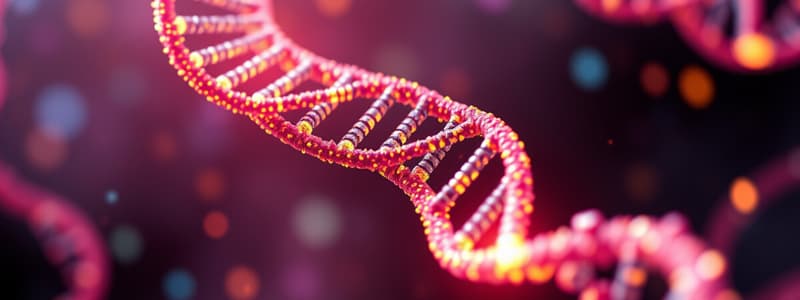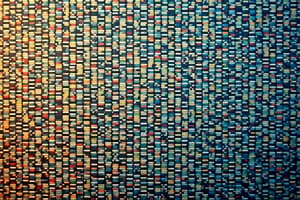Podcast
Questions and Answers
What is the primary purpose of a DNA microarray?
What is the primary purpose of a DNA microarray?
- To synthesize proteins in cells
- To clone specific DNA segments
- To extract RNA from cellular samples
- To detect the expression of thousands of genes simultaneously (correct)
Which step in the DNA microarray process involves converting RNA into cDNA?
Which step in the DNA microarray process involves converting RNA into cDNA?
- Labeling
- Washing
- Sample Preparation (correct)
- Hybridization
What does the intensity of fluorescence in a microarray indicate?
What does the intensity of fluorescence in a microarray indicate?
- The size of the DNA fragment
- The temperature of the sample
- The level of gene expression (correct)
- The presence of DNA mutations
Which of the following is not a limitation of DNA microarrays?
Which of the following is not a limitation of DNA microarrays?
What is one of the key advantages of using DNA microarrays?
What is one of the key advantages of using DNA microarrays?
In which application are DNA microarrays commonly used?
In which application are DNA microarrays commonly used?
What is the role of hybridization in the DNA microarray process?
What is the role of hybridization in the DNA microarray process?
What future direction is suggested for DNA microarray technology?
What future direction is suggested for DNA microarray technology?
Flashcards are hidden until you start studying
Study Notes
DNA Microarray
-
Definition: A DNA microarray is a laboratory tool used to detect the expression of thousands of genes simultaneously.
-
Structure:
- Composed of a solid surface (like glass or silicon) onto which thousands of DNA probes are fixed.
- Each probe corresponds to a specific gene or genetic element.
-
Function:
- Used to measure gene expression levels or to detect mutations.
- Allows for the comparison of gene expression under different conditions or treatments.
-
Process:
- Sample Preparation: RNA is extracted from cells and converted into complementary DNA (cDNA) using reverse transcription.
- Labeling: cDNA is labeled with fluorescent dyes.
- Hybridization: Labeled cDNA is applied to the microarray, where it hybridizes to complementary DNA probes on the chip.
- Washing: Excess, unbound cDNA is washed away.
- Scanning: The microarray is scanned using a laser, detecting the fluorescent signals emitted by bound cDNA.
- Data Analysis: The intensity of the fluorescence indicates the level of gene expression.
-
Applications:
- Identifying gene functions and interactions.
- Profiling gene expressions in diseases (e.g., cancer research).
- Genotyping and SNP detection.
- Personalized medicine and drug response studies.
-
Advantages:
- High-throughput analysis allows for the simultaneous study of many genes.
- Provides a comprehensive view of gene expression in a single experiment.
-
Limitations:
- High cost and complexity in data interpretation.
- Requires careful experimental design to avoid false positives/negatives.
- Limited by the quality and specificity of the probes used.
-
Future Directions:
- Integration with other technologies (e.g., next-generation sequencing).
- Development of more refined and sensitive detection methods.
DNA Microarray Overview
- A DNA microarray is used to assess the expression of thousands of genes at once.
- It consists of a solid surface, typically glass or silicon, adorned with numerous DNA probes.
Structure and Composition
- Each DNA probe on the microarray is linked to a specific gene or genetic element.
Function and Utilization
- Primarily measures gene expression levels and detects genetic mutations.
- Facilitates comparisons of gene expression under various conditions and treatments.
Process of Using a DNA Microarray
- RNA extraction from cells precedes conversion into complementary DNA (cDNA) through reverse transcription.
- The resulting cDNA is labeled with fluorescent dyes for visualization.
- Labeled cDNA is introduced to the microarray, hybridizing with complementary probes.
- Excess unbound cDNA is removed through washing.
- The microarray is then scanned with a laser, capturing fluorescent signals that correlate with gene expression levels.
- Data analysis interprets fluorescence intensity to quantify gene expression.
Applications
- Key in identifying gene functions and understanding gene interactions.
- Crucial for profiling gene expressions in diseases, especially in cancer research.
- Useful in genotyping and detecting single nucleotide polymorphisms (SNPs).
- Aids in personalized medicine, particularly in studying individual drug responses.
Advantages
- High-throughput capabilities provide the ability to study many genes simultaneously.
- Offers a comprehensive overview of gene expression within a single experiment.
Limitations
- The technology is often expensive and complex, with potential challenges in data interpretation.
- Requires meticulous experimental design to reduce risks of false positives or negatives.
- Effectiveness can be limited by the quality and specificity of the DNA probes utilized.
Future Directions
- Expected to integrate with emerging technologies, such as next-generation sequencing.
- Ongoing development aims to enhance detection methods, aiming for greater sensitivity and accuracy.
Studying That Suits You
Use AI to generate personalized quizzes and flashcards to suit your learning preferences.




